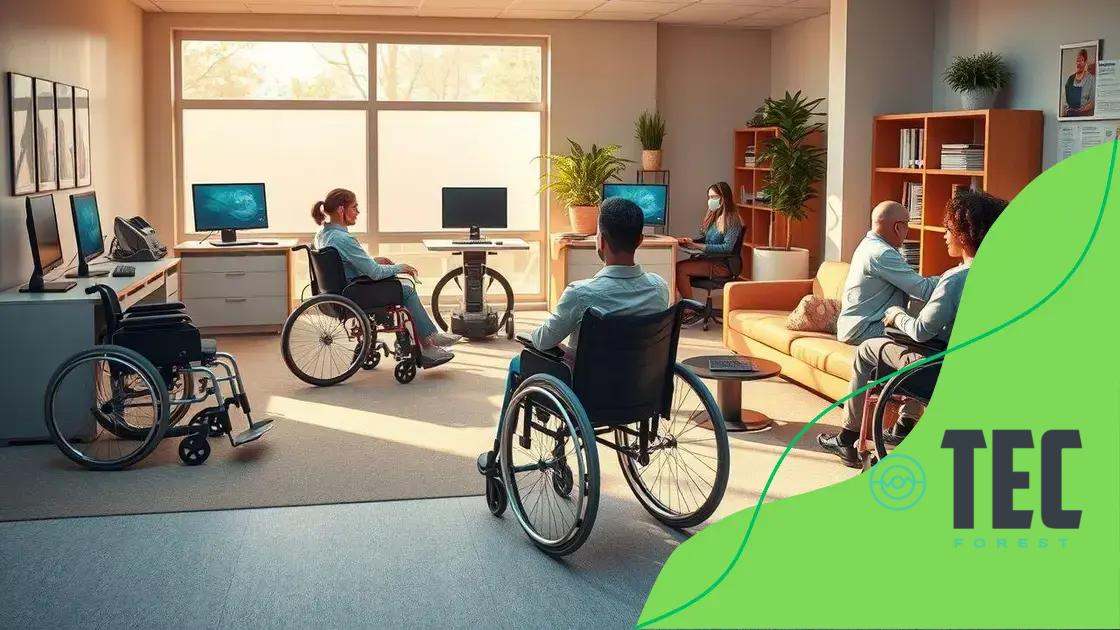Advertisement
Reimbursable disability tech devices significantly enhance the quality of life for individuals with disabilities by improving independence, communication, and access to opportunities, while also easing financial burdens through insurance coverage.
Disability tech devices proposed as reimbursable benefits offer promising solutions that enhance mobility and accessibility for those in need. Have you ever wondered how these devices could change lives? Let’s dive into this topic!
Advertisement
Understanding disability tech devices
Understanding disability tech devices is crucial in enhancing the quality of life for individuals with disabilities. These devices range from simple aids to advanced technology that promotes independence and accessibility.
There are various types of devices designed to assist individuals with different needs. Below are some of the categories:
Advertisement
Types of Disability Tech Devices
- Mobility aids: These include wheelchairs, scooters, and walkers that help people move around more easily.
- Communication devices: Tools like speech-generating devices allow individuals with speech impairments to communicate effectively.
- Hearing aids: These devices enhance sound and help people with hearing loss engage more fully in conversations.
- Adaptive computer technology: Equipment like adaptive keyboards and software that assist individuals in using computers.
Each of these devices is designed to cater to specific needs, making daily tasks more manageable. For instance, mobility aids not only help users navigate but also promote a sense of freedom and confidence.
Moreover, understanding how these devices work and their intended benefits is key. For example, communication devices are not just about the technology; they empower users to express their thoughts and participate in social interactions.
Benefits of Understanding Disability Tech
When people learn about disability tech devices, they can become more supportive allies and advocates. Knowledge promotes empathy and understanding. Those who are aware of available options can help individuals access necessary resources, leading to better integration into society.
Additionally, knowing how to advocate for reimbursable benefits can assist families and individuals navigate financial options available for these devices. It’s essential to ensure that everyone has access to the tools they need.
Embracing technology for disabilities not only transforms lives but also fosters a more inclusive environment. So, understanding these devices is a step towards building a supportive community where everyone can thrive.
Types of reimbursable tech for disabilities

When we talk about types of reimbursable tech for disabilities, it’s important to recognize the variety of devices available to individuals in need. These technologies serve vital purposes, making everyday tasks easier and enhancing quality of life.
Several categories of reimbursable tech are available to help individuals overcome challenges they may face. Understanding these categories is essential in accessing the right tools.
Categories of Reimbursable Tech
- Assistive Mobility Devices: Wheelchairs, scooters, and walkers help individuals move and navigate their environments.
- Communication Aids: Devices like speech-generating tools allow those with speech impairments to communicate effectively and participate in conversations.
- Hearing Assistance: Hearing aids and amplifiers improve sound clarity for individuals with hearing loss.
- Adaptive Computer Equipment: Tools such as special keyboards and software enable users to interact with computers more effectively.
Each of these devices provides unique benefits and can lead to increased independence and confidence. For example, communication aids empower users to express their ideas, bridging gaps in social interactions.
It’s also essential to understand the reimbursement landscape. Many insurance plans offer financial support for these devices, making them more accessible. Families seeking help can inquire with their providers about coverage for necessary equipment.
Adaptive technologies are continually evolving, offering new and innovative solutions. Staying informed about these advancements ensures that individuals can access the latest tools that can significantly improve their daily lives.
By recognizing the various types of reimbursable tech, individuals and their families can make informed decisions when seeking support. This understanding allows for advocating effectively for resources that can foster independence and inclusion.
How reimbursement processes work
Understanding how reimbursement processes work for disability tech is essential for those who need financial support for necessary devices. Knowing the steps involved can make it easier to navigate the often complex world of insurance and funding.
Typically, the reimbursement process involves several key steps that individuals must follow. Gathering all necessary documentation is a critical first step.
Key Steps in the Reimbursement Process
- Evaluate your need: Assess which devices will provide the most benefit based on your specific needs.
- Consult with a healthcare provider: Obtain a prescription or letter of recommendation from a healthcare professional to support your request.
- Gather documentation: Collect receipts, invoices, and any other required information to substantiate your claim.
- Submit your claim: Send all documentation to your insurance provider or the designated reimbursement entity following their specific guidelines.
After submission, it’s vital to keep track of your claim status. It may take several weeks for the insurance company to process the request. During this waiting period, maintaining communication with the provider can be beneficial.
Furthermore, if a claim is denied, there are usually options for appeal. Understanding the reason behind the denial helps in preparing a more robust case for resubmission. Many times, additional documentation or clarification can assist in overturning a denial.
By taking these steps and having the right information, individuals can navigate the reimbursement landscape more effectively. Ultimately, these processes are in place to support individuals, ensuring they receive the necessary tools to enhance their quality of life.
Benefits of reimbursable disability tech

The benefits of reimbursable disability tech are far-reaching and can significantly impact the lives of individuals with disabilities. Access to these technologies fosters independence and enables individuals to participate more fully in their communities.
One major benefit is the improvement in quality of life. Individuals using assistive devices can perform daily activities with greater ease, gaining a sense of control and confidence. This newfound independence can lead to enhanced emotional well-being.
Key Benefits of Reimbursable Disability Tech
- Increased Accessibility: These technologies provide easier access to homes, workplaces, and public spaces, ensuring that everyone can navigate their environment.
- Enhanced Communication: Communication aids help individuals express their needs and ideas effectively, breaking down barriers in social interactions.
- Improved Mobility: Mobility devices allow individuals to move freely and participate in activities with family and friends.
- Boosted Employment Opportunities: Assistive technologies can help individuals stay competitive in the job market by enabling them to perform tasks independently.
Additionally, reimbursement options can ease the financial burden of acquiring these devices. Knowing that insurance or other funding sources will cover the costs makes it easier for families to invest in the tools they need. This support can lead to a more comprehensive approach to disability management.
Ultimately, the integration of reimbursable disability tech into everyday life not only benefits the individuals using the devices but also contributes to a more inclusive society. As communities embrace these technologies, everyone can benefit from the diverse perspectives and talents of individuals with disabilities.
Real-life impacts of these technologies
The real-life impacts of these technologies for individuals with disabilities are profound. By providing essential support, disability tech devices change lives and enhance everyday experiences.
These technologies not only assist in daily tasks but also foster a sense of belonging and participation. For many users, having access to the right tools creates a path toward greater independence.
Transformative Impacts
- Independence: Many individuals find that mobility aids or communication devices allow them to perform everyday tasks without relying on others.
- Social Inclusion: Technology that facilitates communication helps users connect with family and friends, reducing feelings of isolation.
- Enhanced Employment Opportunities: Access to assistive devices can open new job possibilities, allowing individuals to engage in meaningful work.
- Improved Mental Health: Gaining more independence and being able to communicate effectively can lead to increased confidence and decreased anxiety.
For example, consider someone using a speech-generating device. This technology enables them to engage in conversations, express their thoughts, and participate in social activities. The ability to communicate fosters a sense of normalcy and enhances emotional well-being.
Moreover, assistive devices often help individuals set and achieve personal goals. Whether it’s going back to school or simply taking a walk in the park, having the right technology makes these activities accessible.
Overall, the impact of these technologies extends beyond the individual; they reshape perceptions of disability and promote inclusivity within communities. As more people learn about and embrace assistive devices, societal attitudes can gradually shift toward acceptance and support.
FAQ – Frequently Asked Questions about Disability Tech
What are reimbursable disability tech devices?
Reimbursable disability tech devices are tools and technologies that assist individuals with disabilities, and their costs can be covered by insurance or other funding sources.
How can these devices improve my daily life?
These devices enhance independence, improve communication, and enable participation in social activities, leading to a higher quality of life.
What is the reimbursement process like?
The reimbursement process generally involves evaluating the need for a device, obtaining a prescription, gathering documentation, and submitting a claim to your insurance provider.
Why are these technologies important for inclusion?
Reimbursable disability tech promotes social inclusion by making daily activities more accessible, allowing individuals with disabilities to engage more fully in their communities.
